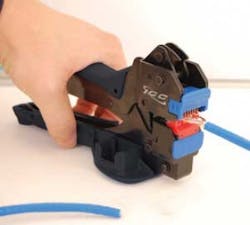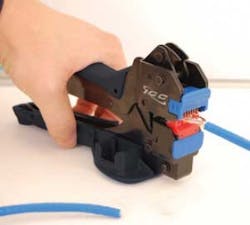Terminate RJ-45s with one squeeze
ICC’s (www.icc.com) JackEasy is described as an all-in-one tool that seats and terminates an 8-position 8-contact RJ-45-style connector, and simultaneously cuts off excess wires, with a single squeeze. It is made with a 16-gauge steel frame and has an ergonomically designed handle. JackEasy includes two blades to terminate ICC’s easy (EZ) and slim-body (HD) style jacks, the company says.
The tool is also designed with a surface base, allowing it to rest on a table or floor for support during termination. The manufacturer says that by using this tool, installers save time because the one-squeeze termination is carried out by a balanced blade that will not damage connectors.
Pinpointing data center planning mistakes
Data center facilities design, construction and management firm Lee Technologies (www.leetechnologies.com) recently released a white paper entitled “The Top 9 Mistakes in Data Center Planning: The Total Cost of Ownership Approach to Building or Expanding Data Centers.” The company says the paper addresses the question, “Why do so many data center builds and expansions fail?” by pointing out the most common, and most significant, mistakes organizations make when designing and building new data center space. The paper also examines an effective way to achieve success through the company’s TCO approach, it says.
Mike Hagan, executive vice president at Lee Technologies and the paper’s author, comments, “Our goal with this paper is to share insights from our more than 25 years of experience designing, building and managing data centers and critical facilities for some of the biggest names in commercial enterprises and government agencies. The TCO approach we recommend will prepare data center leaders to confront various problems that arise during the planning process and position themselves for success.”
While Hagan was the paper’s primary author, other contributors included Lee’s director of technical engineering John Lusky; manager of mechanical engineering Tuan Hoang, P.E.; and mechanical project engineer Scott Walsh, P.E., LEED A.P.
“The data center market outlook shows significant growth in 2010 and 2011,” Hagan adds. “We stand ready to support both commercial and public-sector organizations in developing the most time- and cost-efficient plans to build sustainable data centers that will meet both uptime requirements and future business goals.”
Demarc extensions lack guidance of standards
The white paper entitled “The Demarc Extension and its Critical Role in Enterprise Network Telecommunications Infrastructure” authored by Concert Technologies exposes the fact that the loss of standardization for this important piece of cabling has led to poor installation practices. Addressing the information needs of telecommunications agents and carriers, the paper arms these professionals with the knowledge to ensure the circuit’s complete operability at the time of delivery.
The paper defines the demarc extension as follows: The transmission path originating from the interface of the access provider’s side of the telecommunications circuit demarcation point within a premises, and ending at the termination point prior to the interface of the edge customer premises equipment. This may include in-segment equipment, media converters and patch cords as required to complete the circuit’s transmission path to the edge customer premises equipment.
“This white paper sets industry standards and guidance for the most important transmission path in commercial buildings,” said Dennis Mazaris, developer of Demarc Extension Nationwide (www.demarcextension.com) and president of Concert Technologies (www.concerttech.com). “Without standards and guidelines, the potential to install the demarc extension incorrectly increases and can threaten business and affect productivity. This issue is important for the telecom agent and the carrier to address in order to increase customer satisfaction and ensure future business.”
The paper also emphasizes the impact that this piece of cabling, the demarc extension, has on businesses and buildings across the United States and internationally. It also highlights the following topics: importance of the demarc extension to essential circuit delivery and customer satisfaction; isolating circuit versus inside-wiring problems quickly; the correlation between the loss of standardization and poor installation practices; clarification regarding who is responsible for the installation; installer survey data for demarc extensions; demarc extension standards and resources.
BICSI releases RITP credential details
BICSI (www.bicsi.org) has released its Registered Information Technology Professional (RITP) credential exam application. The RITP is similar to the Registered Communications Distribution Designer (RCDD) credential with the exception that there is no requirement for actual design experience. The focus of the designation are those individuals who work in the information transport systems (ITS) industry but do not design ITS systems, or have limited design experience, including instructors, educators, project managers and sales personnel.
The RITP requires a minimum of two years of industry-related experience, including but not limited to military experience, site or project management, or industry sales. Applicants also need either to have graduated with an Associate of Science, Bachelor of Science, or Master of Science degree in an approved technical field of study or have achieved two or more approved industry certifications. Applicants must also have successfully passed BICSI’s ITS Design Fundamentals exam.
BICSI explains that the primary difference between the RCDD and RITP written exams is the distribution of knowledge versus design-application questions. The RITP exam is focused on the knowledge content of the technology involved in the ITS industry rather than the working application of the technology required to produce design documents for construction and implementation of ITS infrastructure.
The RITP exam includes 150 questions drawn from BICSI’s Telecommunications Distribution Methods Manual. It is a closed-book exam with multiple-choice and true/false questions. The organization recommends a minimum of 125 hours of study in preparation for the exam.
The first RITP beta exam was held during BICSI’s Canadian Conference and Exhibition in May, with another scheduled during its European Conference and Exhibition this month. The first official exam will be held at the 2010 BICSI Fall Conference and Exhibition in September.
Poster highlights 10 fiber-safety rules
A free downloadable poster offered by The Fiber Optic Association (FOA; www.thefoa.org) highlights important safety rules for installers and technicians handling fiber-optic cabling. Derived from the safety section of the FOA’s online reference guide, the poster lists 10 detailed safety measures to take when working with fiber.
“Safety in the lab or on the job site must be the number one concern of everyone,” the FOA says in its online guide. “Besides the usual safety issues for construction, generally covered under OSHA rules, fiber optics adds concerns for eye safety, chemicals, sparks from fusion splicing, disposal of fiber shards and more. Before beginning any installation, safety rules should be posted on the classroom wall, lab wall or on the job site and reviewed with all on-site personnel.”
The poster enables network owners, crew foremen and other responsible personnel to keep fiber safety rules in front of every fiber technician.
Wireless expert addresses mixing Wi-Fi, DAS
In a recent post on The Cabling Blog, Oberon Inc.’s (www.oberonwireless.com) director of engineering and co-founder Scott Thompson discussed dos and don’ts of in-building distributed antenna systems (DAS). As we reported in our April issue, in-building DAS are growing in popularity as wireless-device users demand connectivity everywhere, including inside buildings constructed of materials that can interfere with the wireless antenna systems residing outdoors.
In his post, Thompson notes, “Clearly as people become more dependent on mobile voice and data services, there is a growing expectation for network connectivity everywhere, indoors and outdoors. DAS and related in-building wireless systems provide a means to match this expectation, even in the most challenging indoor environments.”
He stresses, though, that a DAS is a different architecture than the 802.11-based wireless local area network architecture deployed within buildings. 802.11 systems comprise distributed access points with connected antennas, rather than distributed antennas. And he further cautions users not to give in to the temptation to include private wireless LAN traffic over the DAS. “Generally speaking,” he says, “When you use something in a way for which it was not intended, you don’t get the results you want.” He also points out that Cisco (www.cisco.com) has issued a positioning statement indicating the company “does not certify, endorse, or provide RF support for Wi-Fi deployments over any distributed antenna system.”
“Although not specifically precluding the use of Cisco wireless LAN products in a DAS, the statement recommends special consideration of signal coverage, client-to-access point density, client roaming, location-based services, and the impact on the 802.11n antennas used by 802.11n access points,” Thompson says in the blog.
We have asked Thompson to turn his blog entry into a full-scale article for publication in this magazine. He has agreed to do so and we look forward to bringing that article to you in an upcoming issue.

